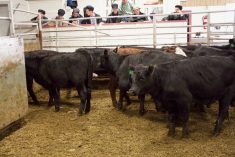Following a cooler-than-normal spring 2022 and the 2021 drought, cattle producers should expect a delay in grass development and growth this spring.
“Air temperature is the main environmental factor that determines the rate of grass development,” says Miranda Meehan, North Dakota State University Extension livestock environmental stewardship specialist. “Each leaf produced on a stem requires a specific amount of accumulated heat, or heat units. The temperature when plants initiate development, or the base temperature, is 32 F (0 C) for cool-season and 40 F (4.5 C) for warm-season grasses. The temperature or heat units that a plant needs to accumulate to produce a leaf can be expressed as growing degree days.”
Read Also

Manitoba boosts stake in cereals centre to $23.5 million
Premier Wab Kinew said the additional project funds will help ‘Trump-proof’ the provincial economy.
According to Kevin Sedivec, rangeland management specialist and interim director of the NDSU Central Grasslands Research Extension Center at Carrington, perennial grasses start to accumulate growing degree days the first day after March 15 that the average daily air temperature exceeds freezing for five consecutive days. The number of growing degree days needed to reach grazing readiness varies between species from 443 days for crested wheatgrass to over 1,000 for most native species. Search online for “NDSU Extension Determining Grazing Readiness” for more information.
“Grazing readiness is the developmental stage where the plant is able to recover from the stress of grazing,” says James Rogers, Extension forage crops production specialist at the NDSU North Central Research Extension Center near Minot. “Grazing readiness for most domesticated pasture is at the three-leaf stage, whereas grazing readiness for most native range grasses is the 3-1/2-leaf stage.
All cool-season grasses, which are the dominant grasses in the region, initiate growth from a tiller that was established the previous growing season. However, drought and/or grazing stress during the fall of 2021 may have caused tillers to die, setting back plant development this spring.
“Pastures that have had tiller loss must be given adequate time to recover,” says Sedivec. “Grazing too early in the spring can result in decreased total forage production for the entire grazing season. You may sacrifice 45 per cent to 60 per cent of forage production for the year by grazing too early.”
Grazing too early will reduce plant vigour, thin existing stands, lower total forage production, and increase disease, insect and weed infestations, says Rogers. Pastures and range damaged by grazing too early and that are severely overgrazed may take several years of deferment or even rest before the stand regains productivity.
A loss of forage production due to grazing prior to grazing readiness will reduce the recommended stocking rate and/or animal performance.
“Due to the combination of cool temperatures and drought stress, producers should expect delays in grazing readiness this spring and manage accordingly,” says Meehan. “This would include avoiding grazing native range until grazing readiness has been achieved.”
Strategies to avoid grazing native range prior to grazing readiness include:
- Grazing domesticated grass pastures, such as crested wheatgrass and smooth brome, in May.
- Providing supplemental forage to livestock on domesticated pasture or hay land.
- Using winter annuals that were established last fall for early-spring grazing or hay.
- Continuing drylot feeding in May.
“While it may be tempting to start grazing early due to a lack of forage resources, it can have long-term impacts on forage production,” warns Sedivec. “Remember, it takes grass to grow grass. Early-spring grazing, especially following a drought, can be costly in terms of total forage production during the entire grazing season.”















